
Dry cupping is a traditional therapeutic practice that involves the application of cups to the skin to create suction. Unlike wet cupping, which involves making small incisions to draw blood, dry cupping solely uses the vacuum effect to pull the skin, muscle, and fascia into the cup. This practice has its roots in ancient cultures, notably in Chinese, Middle Eastern, and Eastern European medicine, and is still widely used today in various parts of the world for its purported health benefits.
Procedure
In dry cupping, cups made of glass, bamboo, ceramic, or silicone are placed on specific areas of the body. The practitioner creates a vacuum inside the cup by either heating the air within it using a flame before quickly placing it on the skin or using a mechanical pump. This suction draws the skin and superficial muscle layer into the cup, causing local congestion and increased blood flow to the area. The cups are typically left in place for five to fifteen minutes.
Mechanism and Benefits
The primary mechanism behind dry cupping is the suction effect, which is believed to increase circulation and promote healing in the targeted tissues. This enhanced blood flow is thought to aid in reducing muscle tension, promoting cell repair, and forming new connective tissues. Additionally, the practice is said to stimulate the lymphatic system, helping the body to remove toxins and waste products.
Commonly Reported Benefits:
- Pain Relief: Cupping is frequently used to alleviate chronic pain, particularly in the back, neck, and shoulders. By increasing blood flow and reducing muscle stiffness, it can help in managing conditions such as arthritis, lower back pain, and muscle spasms.
- Inflammation Reduction: The increased blood flow to the affected areas can help reduce inflammation, making it beneficial for conditions like fibromyalgia and tendonitis.
- Relaxation and Well-Being: Many individuals report feeling a sense of relaxation and well-being after a cupping session. This is possibly due to the release of endorphins and the reduction in muscle tension.
- Improved Skin Health: Some practitioners use cupping to improve skin health, including the treatment of conditions such as acne, eczema, and cellulite by enhancing local blood flow and promoting detoxification.
- Respiratory Health: Cupping is also used in traditional Chinese medicine to address respiratory issues such as coughs, bronchitis, and asthma by applying the cups to the chest and back.
Safety and Considerations
While generally considered safe when performed by a trained professional, dry cupping can cause side effects such as temporary bruising, redness, and mild discomfort due to the suction effect. It is important to ensure that the skin is intact and healthy before applying the cups to avoid irritation or infection. People with certain medical conditions, such as those with clotting disorders, skin conditions, or who are pregnant, should consult with a healthcare provider before undergoing cupping therapy.
Modern Usage
Today, dry cupping is used by a wide range of practitioners, including acupuncturists, massage therapists, and physical therapists, often as part of an integrative approach to health and wellness. Its popularity has been bolstered by endorsements from athletes and celebrities, bringing greater attention to this ancient practice.
In summary, dry cupping is a versatile and ancient therapeutic technique that continues to be valued for its potential health benefits, offering a non-invasive option for pain relief, inflammation reduction, and overall well-being.

